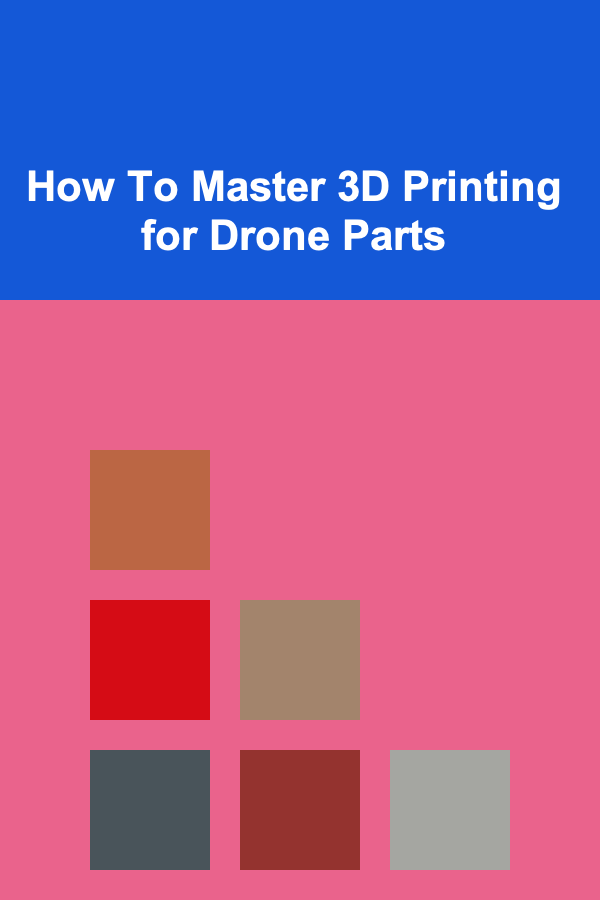
How To Master 3D Printing for Drone Parts
ebook include PDF & Audio bundle (Micro Guide)
$12.99$7.99
Limited Time Offer! Order within the next:

The world of drones has rapidly evolved over the last few years, and one of the most exciting aspects of this technology is the ability to create and customize drone parts using 3D printing. Whether you're a hobbyist looking to build your own drone or a professional aiming to innovate in the aerospace industry, mastering 3D printing for drone parts offers a plethora of opportunities. This article will explore the process in detail, from selecting the right 3D printer and materials to designing drone parts and optimizing the printing process for functional, reliable, and efficient drone components.
The Rise of 3D Printing in Drone Technology
In the past, manufacturing drone parts required expensive molds, tools, and machinery. However, with the advent of 3D printing, the landscape has shifted. This technology allows for rapid prototyping and the ability to produce parts on demand, at a fraction of the cost compared to traditional methods. Furthermore, 3D printing enables the creation of custom drone parts that would be otherwise impossible or too costly to manufacture using conventional methods.
Drones, being complex machines with several components that must work in harmony, benefit greatly from the precision and flexibility that 3D printing provides. From motors and arms to landing gears and camera mounts, nearly every part of a drone can be created using 3D printing techniques, allowing for more efficient designs and enhanced performance.
Understanding the Basics of 3D Printing
Before diving into the specifics of 3D printing drone parts, it's essential to understand how 3D printing works. At its core, 3D printing (also known as additive manufacturing) involves creating objects layer by layer from a digital design. The most common 3D printing techniques for drone parts include Fused Deposition Modeling (FDM), Stereolithography (SLA), and Selective Laser Sintering (SLS).
FDM (Fused Deposition Modeling)
FDM is one of the most popular 3D printing technologies. In this process, a thermoplastic filament is heated and extruded through a nozzle, building up the object layer by layer. FDM printers are widely used for drone parts because of their affordability and ease of use. However, the quality of the parts can vary depending on the material used and the printer's calibration.
SLA (Stereolithography)
SLA uses a laser to cure liquid resin into solid layers, creating a highly detailed and smooth finish. This method is typically used for parts that require a high level of precision and smooth surfaces, such as camera mounts or small, intricate components. However, SLA printing can be slower and more expensive compared to FDM.
SLS (Selective Laser Sintering)
SLS is a more advanced form of 3D printing that uses a laser to sinter powdered material (such as nylon, metal, or ceramics) into solid parts. This process allows for stronger and more durable parts, which is essential for drone components that need to withstand significant stress and wear. While SLS printers are typically more expensive and require specialized equipment, the resulting parts are often superior in terms of strength and functionality.
Choosing the Right 3D Printer for Drone Parts
The choice of 3D printer is crucial when it comes to printing drone parts. Several factors should be considered, including the size of the drone parts, the material requirements, and the printer's cost. Below are some key considerations:
3.1. Build Volume
The build volume of a 3D printer refers to the maximum size of an object that can be printed. Drones often require a variety of components, ranging from small camera mounts to large frame pieces. If you're printing larger drone parts, make sure that your 3D printer has a build volume that can accommodate the size of your components.
3.2. Printing Resolution
Resolution is essential for creating high-quality drone parts. High-resolution printing ensures that the details of your parts are crisp and clear, which is particularly important for components like propellers, motor mounts, and camera brackets. Look for a printer that offers a high level of accuracy and fine details, especially if you're printing complex or small parts.
3.3. Material Compatibility
Different 3D printers support different types of materials. The material you choose will have a direct impact on the strength, weight, and durability of your drone parts. Some of the most commonly used materials for 3D printing drone parts include:
- PLA (Polylactic Acid): PLA is a biodegradable plastic that is easy to print and works well for prototypes and non-load-bearing parts.
- ABS (Acrylonitrile Butadiene Styrene): ABS is a tougher plastic that offers better heat resistance and durability, making it ideal for structural parts.
- Nylon: Nylon is a strong, flexible material that can withstand stress and impact, making it perfect for parts like arms, landing gear, and brackets.
- Carbon Fiber Reinforced Filaments: These filaments are made by combining nylon with carbon fiber, creating a lightweight yet incredibly strong material. They are ideal for creating drone parts that need to be both lightweight and durable.
3.4. Printer Type
When selecting a 3D printer, it's important to choose between a DIY kit or a fully assembled printer. While DIY kits can be more affordable and customizable, they often require more setup and technical knowledge. Fully assembled printers are easier to use but may be more expensive. Consider your budget and skill level before making a decision.
Designing Drone Parts for 3D Printing
Once you've chosen the right printer, the next step is designing the drone parts. Drone designs must take into account not only the functional requirements of the components but also the limitations of 3D printing. Here are some tips for designing drone parts that are optimized for 3D printing:
4.1. Use CAD Software
Designing drone parts requires precision, and Computer-Aided Design (CAD) software is the primary tool used by engineers and designers. Popular CAD programs for 3D printing include SolidWorks, Fusion 360, and TinkerCAD. These programs allow you to create detailed 3D models of your drone parts and export them in a format compatible with 3D printers, such as STL or OBJ.
4.2. Optimize for Strength and Weight
Drones need to be lightweight to ensure efficient flight times and performance. However, drone parts must also be strong enough to withstand the stresses of flight. When designing parts, focus on creating structures that are both lightweight and strong. You can achieve this by using honeycomb or lattice structures that maintain strength while reducing material usage and weight.
4.3. Consider Material Properties
Different drone parts require different material properties. For example, the frame of a drone needs to be strong and rigid, while the arms might benefit from being slightly flexible to absorb impacts. Be sure to choose the right material for each part based on the performance requirements.
4.4. Account for Post-Processing
While 3D printing can create detailed parts, some parts may require post-processing to achieve the desired finish. This could include sanding, painting, or adding coatings for durability. Keep post-processing in mind when designing your parts to ensure that they can be easily finished and assembled.
3D Printing Techniques for Drone Parts
Once your design is ready, it's time to print the drone parts. Each 3D printing technique offers unique advantages and challenges, so understanding how to optimize your design for each technique is key.
5.1. FDM Printing for Drone Frames
FDM printing is often used for printing larger drone components like frames and arms. To ensure that the parts are strong and functional, consider the following tips:
- Layer Height: Use a smaller layer height for better resolution, but balance it with print speed. For drone frames, a layer height of 0.2mm is often sufficient.
- Infill: The infill percentage determines how much material is used inside the part. For drone frames, a higher infill (around 50-60%) will provide the necessary strength without adding unnecessary weight.
- Supports: Depending on the complexity of the part, you may need to use support structures to prevent overhangs from sagging. Ensure that the supports are easy to remove after printing.
5.2. SLA Printing for Camera Mounts and Small Parts
For parts that require fine details and smooth finishes, SLA printing is ideal. This technique is particularly useful for printing small, intricate components like camera mounts or gimbals. Keep in mind the following:
- Resolution: SLA printers offer high resolution, which is great for small parts with fine details.
- Post-Processing: SLA prints require post-processing to remove the resin and cure the parts. Make sure to clean and cure the parts properly to ensure strength and durability.
5.3. SLS Printing for Structural Components
SLS printing is great for creating structural parts that need to be both strong and lightweight. This method is ideal for creating high-performance drone components, such as motor mounts or landing gear. SLS printing allows for more complex geometries, such as internal channels and lattice structures.
Testing and Iterating Your Drone Parts
Once your parts are printed, it's time to test them. Testing is crucial to ensure that the parts function properly and meet the performance requirements of your drone. Perform a variety of tests, including:
- Structural Testing: Test the strength and durability of the parts by subjecting them to stress and impact.
- Flight Testing: Assemble your drone and perform flight tests to evaluate the performance of the printed parts in real-world conditions.
- Iterative Design: Based on the test results, iterate on your designs to improve performance and address any issues that arise.
Scaling Up Production
Once you've mastered the process of 3D printing individual drone parts, you can begin to scale up production. If you're creating custom drone parts for a large project, such as a fleet of drones, you may need to consider batch printing or outsourcing the production to a professional service. However, keep in mind that scaling up will require attention to quality control and consistency.
Conclusion
Mastering 3D printing for drone parts is an exciting and rewarding endeavor that opens up new possibilities for innovation and customization. By understanding the different 3D printing techniques, selecting the right materials, designing optimized parts, and testing thoroughly, you can create high-performance, functional, and reliable drone components. Whether you're building drones for personal use or industrial applications, 3D printing offers unparalleled flexibility and cost-efficiency, making it an invaluable tool in the drone enthusiast's toolkit.

How to Choose the Best Party Invitations for Your Home Party
Read More
How to Choose the Right Argos Floor Lamps for Your Living Space
Read More
How to Document Your Seasonal Changes for Personal Reflection
Read More
How to Organize Your Kitchen Pantry for Easy Access
Read More
Monetizing Deep Learning: Earning Passive Income from AI
Read More
Mastering Grilling Marinades: A Comprehensive Guide
Read MoreOther Products

How to Choose the Best Party Invitations for Your Home Party
Read More
How to Choose the Right Argos Floor Lamps for Your Living Space
Read More
How to Document Your Seasonal Changes for Personal Reflection
Read More
How to Organize Your Kitchen Pantry for Easy Access
Read More
Monetizing Deep Learning: Earning Passive Income from AI
Read More